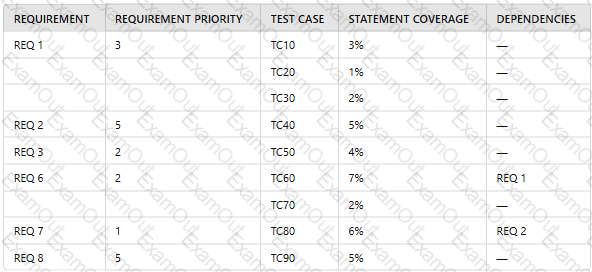Consider the following table, which contains information about test cases from the test management system:

Which ONE of the following optionsorganizes the test cases based on the statement coverage strategy, while considering practical constraints?
Which of the following statements about checklist-based testing is TRUE?
A program is used to control a manufacturing line (turn machines on and off. start and stop conveyer belts, add raw materials to the flow. etc.). Not all actions are possible at all times. For example, there are certain manufacturing stages that cannot be stopped - unless there is an emergency. A tester attempts to evaluate if all such cases (where a specific action is not allowed) are covered by the tests.
Which coverage metric will provide the needed information for this analysis?
Which of the following is a factor that contributes to a successful review?
A test manager decided to skip static testing since he believes bugs can be found easily by doing dynamic testing. Was this decision right or wrong?
Which one of the following is a typical entry criteria for testing?
Which statement is true regarding confirmation testing and regression testing?
A Test Manager conducts risk assessment for a project. One of the identified risks is: The sub-contractor may fail to meet his commitment". If this risk materializes. it will lead to delay in completion of testing required for the current cycle.
Which of the following sentences correctly describes the risk?
Use Scenario 1 “Happy Tomatoes” (from the previous question).
When running test caseTC_59, the actual result fort = 35degrees Celsius isOUTPUT = Xinstead of the expected output.
Which information should NOT be included in the defect report?
For the same financial institution in Question 12, with the same requirements and expectations, what would be the most likely investment values used in testing if two-point boundary value analysis is used to design test cases specific to the 13% interest rate equivalence partition?

